Pima Air & Space Museum’s fleet of Boeing jetliners continues to grow. Thanks to Cathay Pacific and Boeing, PASM now has a 777. The aircraft, line number WA001 (the first 777 built), flew non-stop from Cathay Pacific’s home airport in Hong Kong to Davis-Monthan AFB in Tucson, Arizona, landing around 11 AM Tuesday morning. After defueling, PASM restoration volunteers towed it across Valencia Road onto museum grounds. It’s currently in the restoration yard, and I expect it to be put on display soon.
Per Boeing, this was the first 777 built, completed on 12 June 1994. The company used it as a test aircraft until selling it to Cathay Pacific in 2000. CP retired it in May 2018. During its time with CP, the 777 completed 20,519 flights and recorded 49,687 flight hours.
 |
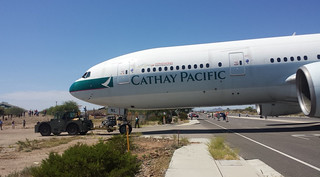 |
Currently on display at PASM are the second prototype 787 Dreamliner and a former China Southern 737-300. Still awaiting restoration: Boeing 727 #5, the first one the company sold (to United Airlines in October 1963); also the first 727 to carry passengers on a commercial flight (March 1964).
I might be jumping the gun here, but if the rumor we’re soon to get a C-5 Galaxy from the Boneyard is true, I hope the museum is negotiating with Pima County for additional acreage!
Some new developments at the museum itself, not aircraft but important nevertheless:
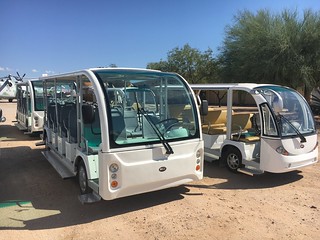 |
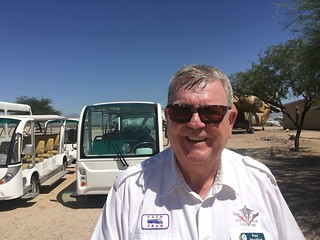 |
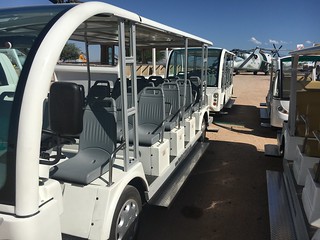 |
 |
These are the museum’s new electric trams. I’m a tram tour docent at PASM and have been looking forward to the arrival of these units. Well, they’re here now and in use (I happen to have been the first tram docent checked out on them, just last week). The larger of the two trams has seats for 48; the smaller one 16 plus a wheelchair platform and ramp.
But wait … those were last week’s numbers. When I went in this Monday, the museum staff had decided to cap ticket sales for the large tram to 34 passengers, 12 for the smaller one. Although the number of actual seats is larger, they’re narrow and close together, putting visitors shoulder to shoulder and hip to hip. I suspect some of the first museum guests to ride the new trams complained about cramped quarters and unwanted physical contact with strangers.
It’s going to be an adjustment. The old gasoline trams could carry 52 and 48 visitors respectively, and during peak season we’d often have to run both trams at once to accommodate all the guests who wanted to take tours. This, of course, is a problem for the museum, not me personally.
My personal problem, and one I suspect will affect many other tram docents, is that the larger of the two electric trams is torture to drive. The small one’s awesome. The driving position and controls are set up right, and it’s as comfortable to operate as my car … but with its limited seating, it won’t see daily use. Based on the number of visitors who sign up for tram tours every day, it’s the big one that’ll be in constant demand, and it’s not driver-friendly, not at all. The driver’s seat is right up against the steering wheel, and neither it nor the steering column are adjustable. There’s only a tiny bit of leg and foot room for the driver, and worse yet, the accelerator and brake pedals are four to five inches above the floor, forcing the driver to lift his or her entire foot up in the air to work them.
It’s not just comfort, it’s control. Think about how you work the pedals in your own car: you rest your heel on the floor and pivot your foot to work the accelerator and brakes. You’re in control; you can make small, precise muscle movements with no strain on your leg. But in this tram, with nothing to rest your heel on, you have to lift your leg and hold your foot in the air to work the pedals. Precise control is next to impossible. And comfort? How many of you, in a sitting position, can hold your right foot off the floor for more than a few seconds at a time?
I quickly learned I couldn’t, never mind for an entire hour-long tram tour (of which I usually do two, sometimes three, per volunteer shift). After my first test run last week, I had an idea: I borrowed a thick book from the docent library to use as a footrest. The book brought my foot up a couple of inches, allowing me to plant my heel and pivot my foot to work the pedals. This Monday I took my own footrest to work, one I made at home with wood and duct tape, similar in size and shape to last week’s book (it’s okay, it was a crappy Tom Clancy novel).
The footrest helps, but it’s not enough. With my recent surgery, bending my knee at the sharp angle required to drive the new tram (an angle made more acute by the elevated footrest), I was limping after one tour and practically dragging my right leg after two. I don’t imagine the museum will want to fabricate brackets to move the driver’s seat back a couple of inches, but that is what’s really needed. Meanwhile, what was a fun job has become a physically painful one.
This is terribly disturbing to me … I love what I do at the museum, but expect if I complain they’ll tell me to take a hike, as they have to so many other dedicated volunteers.
Sorry, didn’t mean to unload, but hey, what are personal blogs for, right?
On a happier note, here’s our new volunteer center, open for business:
 |
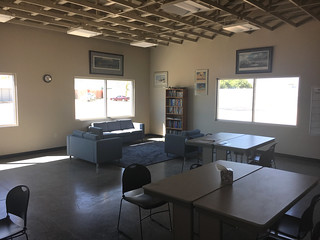 |
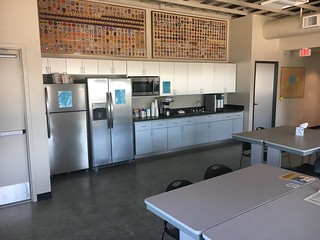 |
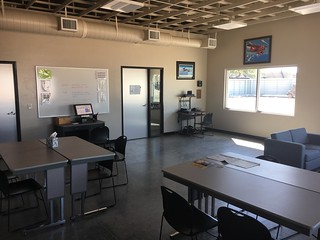 |
The best part is that everything volunteers need is in one place now. The keys to the trams, the walkie-talkies, the mics, the computer we use to log in and out … we no longer have to traipse across the museum grounds every morning to sign in at one place and get the equipment we need at another, then retrace our steps at the end of the day to sign out and turn stuff in. Not only is it a nice lounge, we have our own restroom (non-public, I mean, not full of screaming schoolkids). Someday soon we’ll have curtains or window blinds too!
Well, that’s enough brave new world for now. I want to share a tale with you. This Monday I told the story of a dramatic air-sea rescue to the guests on my tram. In 1994, when I was PACAF chief of flight safety at Hickam Field, Hawaii, an American F-16 pilot stationed at Misawa Air Base in Japan collided with an air refueling tanker over the Pacific, 200 to 300 miles east of Tokyo. He ejected and when I was called in, was still floating in a one-man life raft, with other F-16s circling overhead. My first thought was that he might not get rescued for some time (or, god forbid, even at all) … he was too far out for rescue choppers, and the odds of being picked up by a passing ship were pretty small. Everyone in PACAF, from the four-star on down, was worried sick.
Turned out the Japanese Maritime Self Defense Force operated amphibious fixed wing rescue aircraft (and still do to this day). The Japanese crew of a Shin Meiwa US-1A, flying right to the limit of its range, was able to get to the crash site, make a very sporty water landing in heavy waves, and rescue our pilot. We got word around noon in Hawaii, and everyone’s mood changed instantly.
After I retired I worked as a defense contractor, conducting flight safety training for USAF fighter crews at bases around the US and overseas. Sometime in 2002 or thereabouts I was at Nellis AFB in Las Vegas, Nevada, standing in front of a room full of target arms, otherwise known as Fighter Weapons School instructors. I decided to start things off with the story of the F-16 pilot’s rescue. As I got into it I heard some chuckles. Right there in the first row was a lanky guy in a flight suit wearing a name tag that said “Splash,” and I said, “Oh my god, you’re the dude, right?” He was indeed, and after class he filled me in on his ordeal, including a detail that has stuck with me ever since: his own assessment of the situation, once he pulled himself, soaking wet and shivering, into the raft in the middle of that huge, empty ocean … he thought he might just be a goner.
So anyway, I shared this story with the people on my tram, and afterward one of them walks up to me and introduces himself. He was the air attache at the American Embassy in Tokyo when that happened, and he told me a part of the story I didn’t know, the part about the heroic crew of that JMSDF flying boat.
As I knew, they had pressed the limits to get to our guy. What I didn’t know was that they actually violated flying regulations to do it. The JMSDF brass threw the book at the crew, grounding them and putting the wheels in motion for a court-martial, and it was only pressure from high up in the American government that talked them out of it. The crew eventually received medals for the rescue, but the ceremony was low-key and conducted in secret.
It was fascinating to hear another side of the story, and it brought home to me, once again, what a small world it is. You never know who you’re going to meet at the museum, and believe me, I’ve internalized the most important lesson about sharing there-I-was war stories … never embellish the facts, because someone in your audience might have been there too.
Marvelous story about the rescue. Thanks.